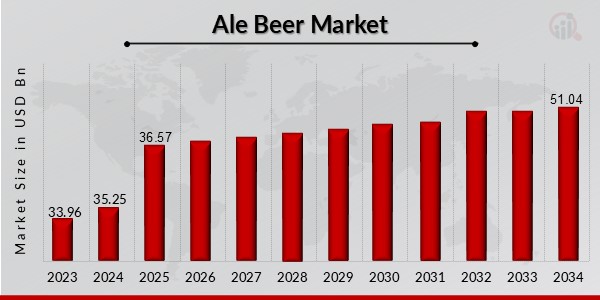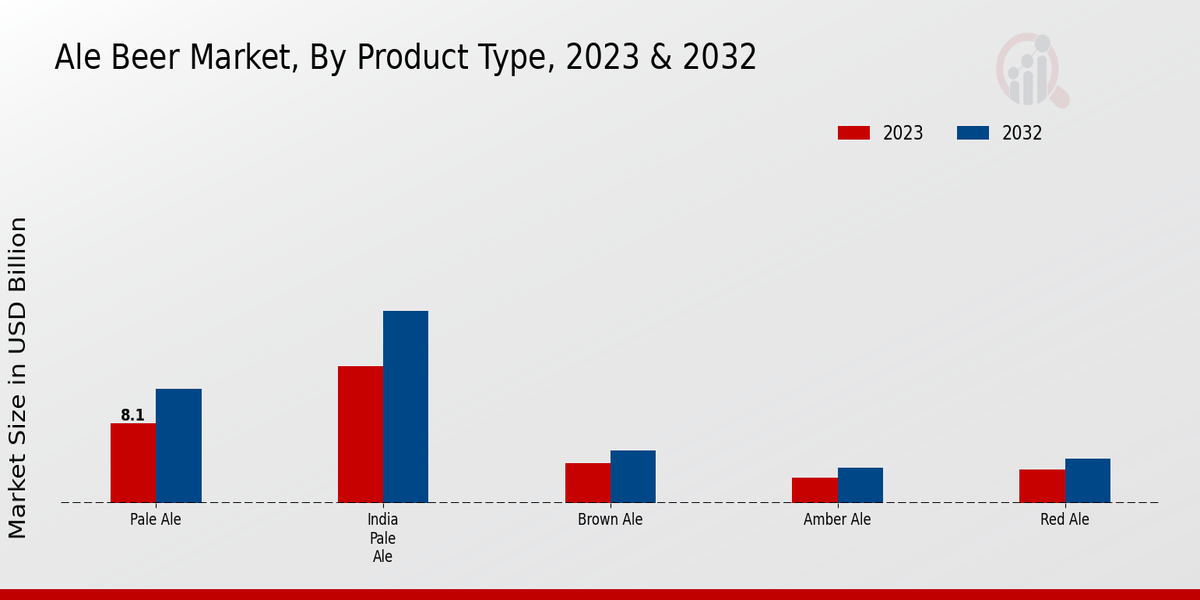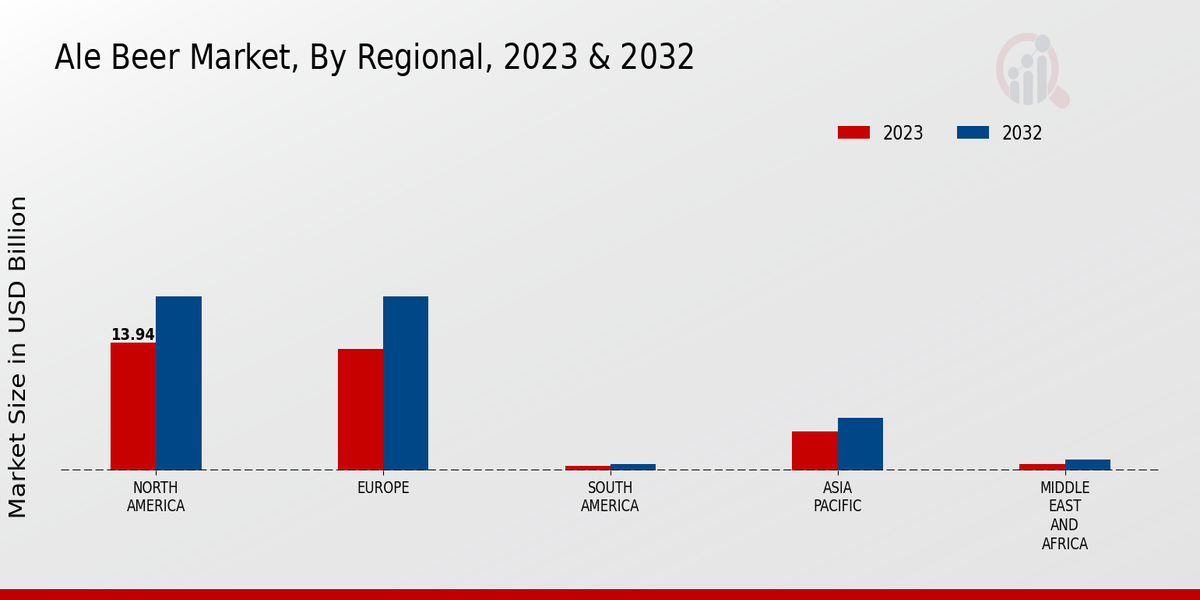Global Ale Beer Market Overview
Ale Beer Market Size was estimated at 35.25 (USD Billion) in 2024. The Ale Beer Industry is expected to grow from 36.57 (USD Billion) in 2025 to 51.04 (USD Billion) by 2034. The Ale Beer Market CAGR (growth rate) is expected to be around 3.8% during the forecast period (2025 - 2034).

Source Primary Research, Secondary Research, MRFR Database and Analyst Review
Key Ale Beer Market Trends Highlighted
Amid heightened health consciousness among consumers striving for healthier alcohol drinks with lower calorie and carbohydrate content, the Ale Beer market is experiencing a strong influence. The demand for craft and specialty beers, which include ales, has been increasing in line with the growing preference for artisanal brews that are rich in taste. The market is also driven by the growing preference for local and regional craft beers as people seek to have something unique and authentic. Furthermore, premium and super-premium ales have become more available either through retail channels or online.
There are growth opportunities within the Ale Beer market, like the expansion of e-commerce platforms that provide convenience and a wider selection of ales for consumers. The home brewing trend is also helping to unlock new opportunities in the market as customers seek ways they could make their brands of ale. Also, there is an emerging interest in low- and no-alcohol ales, which creates room for expansion as customers seek out substitutes for conventional alcoholic drinks.
Emerging patterns in the Ale Beer market include the upswing of sour and wild ales that provide an opportunity to taste different flavors. It has also become common for brewers to try out new ingredients, such as fruits, spices and herbs, thereby making their ales innovative and unique from each other. Furthermore, there is a growing emphasis on sustainability, hence the adoption of eco-friendly practices and packaging solutions in the industry.
Ale Beer Market Drivers
Increasing Health Consciousness
Consumers are becoming increasingly health-conscious and are looking for healthier alternatives to traditional alcoholic beverages. Ale beer is a relatively low-calorie and low-carb option compared to other types of beer, and it also contains antioxidants and other nutrients. As a result, ale beer is becoming a more popular choice for health-conscious consumers who are looking for a more balanced and healthy lifestyle. The Ale Beer Market Industry is expected to witness substantial growth over the forecast period owing to the increasing health consciousness among consumers.
Growing Popularity of Craft Beer
The craft beer segment is growing rapidly as consumers are becoming more interested in unique and flavorful beers. Ale beer is a popular choice for craft brewers because it is relatively easy to brew and can be customized to create a wide range of flavors. The growing popularity of craft beer is expected to drive the growth of the ale beer market in the coming years. The Ale Beer Market Industry is projected to grow significantly over the forecast period due to the rising popularity of craft beer.
Expansion of Distribution Channels
The expansion of distribution channels is another key factor that is driving the growth of the ale beer market. Ale beer is now available in a wider range of retail outlets, including supermarkets, convenience stores, and online retailers. This increased availability is making it easier for consumers to find and purchase ale beer, which is expected to drive growth in the coming years. The Ale Beer Market Industry is anticipated to witness steady growth over the forecast period attributed to the expansion of distribution channels.
Ale Beer Market Segment Insights
Ale Beer Market Product Type Insights
The Ale Beer Market is segmented based on product type into Pale Ale, India Pale Ale, Brown Ale, Amber Ale, Red Ale, and Stout. In 2023, the India Pale Ale segment held the largest market share, making up over 35% of the market revenue worldwide. The most relevant factor contributing to the prominence of this type is the hop flavor and aroma recognizable immediately in IPA beer and significantly appreciated by a large part of the target audience. Moreover, the Pale Ale segment is expected to grow notably in the forecast period as the demand for craft beer is increasing, and people become more health-conscious in terms of beer products, expecting low-calorie and low-carbohydrate beverages.The Brown Ale segment is the second-largest contributor of market revenue with approximately 25% in 2023, because of the nutty and caramel characteristics, which are appealing to those consumers that prefer a balanced flavor experience. The Amber Ale segment is often consumed by people who enjoy a session, as well as Red Ale, with up to 10% contributing to the relevance of the beer variety. The slightly bitter taste of Red Ale combined with the reddish hue can be appealing to a limited number of consumers. Stout, with its dark color, creamy head, and roasted flavor, is among others that it is preferred by a variety of consumers.The growth of the analyzed market types can be justified by the fact that ale beer is tending to gain in importance because of an increasing interest in craft beer and a growing demand for new beer flavors. In turn, the growing number of festivals and tasting events on the market should be mentioned.

Source Primary Research, Secondary Research, MRFR Database and Analyst Review
Ale Beer Market Alcohol Content Insights
The Alcohol Content segment is a key factor in driving the Ale Beer Market growth. The segment is divided into three sub-segments Low-Alcohol, Mid-Alcohol, and High-Alcohol. Low-alcohol ale beer is gaining popularity due to its lower calorie content and refreshing taste. Mid-alcohol ale beer is the most popular segment, accounting for a significant share of the overall market. High-alcohol ale beer is preferred by a niche segment of consumers who enjoy the intense flavor and aroma. In 2023, the Low-Alcohol segment is expected to reach a market value of USD 6.73 billion, while the Mid-Alcohol segment is projected to be worth USD 18.27 billion.The High-Alcohol segment is estimated to reach a market size of USD 7.89 billion by 2032. The growth of the Ale Beer Market is attributed to the increasing demand for premium and craft beers, as well as the growing popularity of low- and non-alcoholic beverages. The market is also expected to benefit from the rising disposable income and changing consumer preferences.
Ale Beer Market Distribution Channel Insights
The Ale Beer Market segmentation by Distribution Channel comprises On-Trade and Off-Trade. In 2023, the On-Trade segment held the larger market share, accounting for around 55% of the Ale Beer Market revenue. The Off-Trade segment is projected to grow at a faster CAGR during the forecast period due to the increasing popularity of online shopping and home deliveries. The growth of the Off-Trade segment is also attributed to the rising number of convenience stores and supermarkets, which offer a wide variety of Ale Beer brands. The Ale Beer Market is expected to reach a valuation of around USD 34.63 Billion by 2024, expanding at a CAGR of 4.1% during the forecast period of 2023-2032.
Ale Beer Market Packaging Insights
Packaging segments the Ale Beer Market into Bottles, Cans, and Kegs. Bottles held the largest market share in 2023, accounting for over 45% of the revenue. The growing popularity of craft beers and the premiumization of the beer industry are driving the demand for bottled ale beer. Cans are expected to witness the fastest growth during the forecast period, owing to their convenience and portability. Kegs are primarily used in the on-trade channel and are expected to grow at a steady pace.
Ale Beer Market Flavors Insights
The Ale Beer Market is segmented by flavors into Hoppy, Malty, Fruity, Citrusy, and Spicy. The Hoppy flavor segment is projected to lead the market in terms of revenue, accounting for 30% of the market share in 2023. The increasing popularity of India Pale Ales (IPAs) and other hoppy beers is driving the growth of this segment. The Malty flavor segment is expected to hold the second-largest market share, followed by the Fruity, Citrusy, and Spicy flavor segments. The growing demand for craft beers with unique and flavorful profiles is contributing to the growth of these segments.
Ale Beer Market Regional Insights
The Ale Beer Market is segmented into North America, Europe, APAC, South America, and MEA. Among these regions, North America is expected to hold the largest market share in 2023, owing to the increasing popularity of craft beers and the presence of major breweries in the region. The European market is also expected to witness significant growth, driven by the growing demand for premium and flavored beers. The APAC region is expected to be the fastest-growing market, with countries such as China and India experiencing a surge in demand for ale beer.South America and MEA are expected to contribute a smaller share of the overall market, but these regions are also expected to witness steady growth in the coming years.

Source Primary Research, Secondary Research, MRFR Database and Analyst Review
Ale Beer Market Key Players And Competitive Insights
Major players in the Ale Beer Market are constantly innovating to enhance their production processes and expand their market reach. They are investing heavily in research and development to create unique and flavorful ale beer variants that cater to the evolving preferences of consumers. The Ale Beer Market industry is also witnessing strategic partnerships and collaborations between major players to strengthen their market position and gain a competitive edge. Leading Ale Beer Market players are expanding their distribution networks and leveraging online platforms to reach a wider customer base. The Ale Beer Market development is being driven by increasing disposable income, changing lifestyle choices, and the growing popularity of craft beer culture. The Ale Beer Market Competitive Landscape is expected to remain highly competitive in the coming years, with major players focusing on product innovation, market expansion, and strategic partnerships to maintain their market share.Anheuser-Busch InBev, the leading company in the Ale Beer Market, has a strong presence and a diverse portfolio of Ale Beer brands.
The company is focused on innovation and sustainability and has invested heavily in renewable energy and water conservation initiatives. Anheuser-Busch InBev has a strong distribution network and marketing capabilities, which enable it to reach a wide range of consumers around the world. The company is also actively involved in community engagement and social responsibility programs.Heineken, a leading competitor in the Ale Beer Market, has a strong presence in Europe, Asia, and Africa. The company is known for its premium beer brands and its focus on quality and innovation. Heineken has a distribution network and a strong marketing team, which enable it to reach a large number of consumers. The company is also committed to sustainability and has implemented various initiatives to reduce its environmental impact.
Key Companies in the Ale Beer Market Include
- Anderson Valley Brewing Company
- Deschutes Brewery
- Pernod Ricard
- Lagunitas Brewing Company
- Constellation Brands, Inc.
- Boston Beer Company
- Carlsberg Group
- Heineken N.V.
- Kirin Holdings Company, Limited
- Rogue Ales
- Asahi Group Holdings, Ltd.
- Diageo plc
- AnheuserBusch InBev
- Sierra Nevada Brewing Company
- Molson Coors Beverage Company
Ale Beer Market Industry Developments
The ale beer market is projected to reach USD 45.67 billion by 2032, exhibiting a CAGR of 3.77% during the forecast period. The increasing popularity of craft beers, rising disposable income, and growing health consciousness among consumers are major factors driving market growth. The Asia-Pacific region is expected to witness significant growth due to the increasing demand for premium and imported beers. Technological advancements such as automated brewing systems and e-commerce platforms are also contributing to market expansion. Recent news developments include the launch of new ale beer variants by major players and the growing adoption of sustainable brewing practices.
Ale Beer Market Segmentation Insights
-
Ale Beer Market Product Type Outlook
- Pale Ale
- India Pale Ale
- Brown Ale
- Amber Ale
- Red Ale
- Stout
-
Ale Beer Market Alcohol Content Outlook
- Low-Alcohol
- Mid-Alcohol
- High-Alcohol
-
Ale Beer Market Distribution Channel Outlook
-
Ale Beer Market Packaging Outlook
-
Ale Beer Market Flavors Outlook
- Hoppy
- Malty
- Fruity
- Citrusy
- Spicey
-
Ale Beer Market Regional Outlook
- North America
- Europe
- South America
- Asia-Pacific
- Middle East and Africa
| Report Attribute/Metric |
Details |
| Market Size 2024 |
35.25 (USD Billion) |
| Market Size 2025 |
36.57 (USD Billion) |
| Market Size 2034 |
51.04 (USD Billion) |
| Compound Annual Growth Rate (CAGR) |
3.8% (2025 - 2034) |
| Report Coverage |
Revenue Forecast, Competitive Landscape, Growth Factors, and Trends |
| Base Year |
2024 |
| Market Forecast Period |
2025 - 2034 |
| Historical Data |
2019 - 2022 |
| Market Forecast Units |
USD Billion |
| Key Companies Profiled |
Anderson Valley Brewing Company, Deschutes Brewery, Pernod Ricard, Lagunitas Brewing Company, Constellation Brands, Inc., Boston Beer Company, Carlsberg Group, Heineken N.V., Kirin Holdings Company, Limited, Rogue Ales, Asahi Group Holdings, Ltd., Diageo plc, Anheuser-Busch InBev, Sierra Nevada Brewing Company, Molson Coors Beverage Company |
| Segments Covered |
Product Type, Alcohol Content, Distribution Channel, Packaging, Flavors, Regional |
| Key Market Opportunities |
Craft beer movement Health-conscious consumers Growing popularity of craft beer in emerging markets Ecommerce and subscription services Innovative flavors and packaging |
| Key Market Dynamics |
Increasing Popularity of Craft Beer Growing Demand for Premium Beers Surge in HealthConscious Consumers Rise of Ecommerce Platforms Expanding Distribution Channels |
| Countries Covered |
North America, Europe, APAC, South America, MEA |
Frequently Asked Questions (FAQ) :
The Ale Beer Market is expected to reach a valuation of 35.25 Billion USD in 2024.
The Ale Beer Market is projected to grow at a CAGR of 3.8% from 2025 to 2034.
The Asia-Pacific region is expected to be the fastest-growing region in the Ale Beer Market, followed by North America and Europe.
Some of the key players in the Ale Beer Market include Anheuser-Busch InBev, Heineken, Carlsberg Group, Molson Coors Beverage Company, and Diageo plc.
Ale Beer is primarily consumed as an alcoholic beverage and is often used in cooking and baking.
Key trends shaping the Ale Beer Market include the growing popularity of craft beers, the increasing demand for low- and no-alcohol beers, and the rising popularity of online beer sales.
Key challenges facing the Ale Beer Market include rising raw material costs, intense competition, and changing consumer preferences.
The Ale Beer Market is expected to reach a valuation of 51.04 Billion USD by 2034.
Major factors driving the growth of the Ale Beer Market include increasing disposable income, growing urbanization, and changing lifestyles.
Major opportunities for growth in the Ale Beer Market include expanding into emerging markets, developing new product offerings, and investing in marketing and advertising.

















